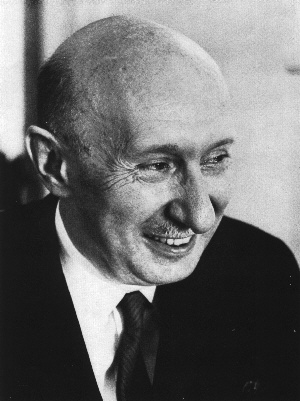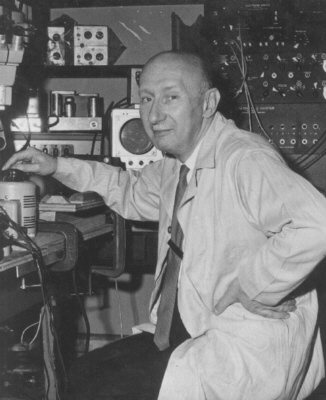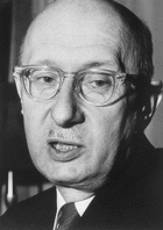¡@

Georg von Bekesy (1899 - 1972)
Georg von Békésy was born in Budapest, Hungary on June 3, 1899. He received his early education in Munich, Constantinople, Budapest, and Zurich and studied chemistry at the University of Berne. He was awarded his Ph.D. from the University of Budapest in 1926 for development of a fast method for determining molecular weight. Afterwards he worked primarily for the Hungarian Telephone and Post Office Laboratory in Budapest where his interests were directed towards problems of telecommunications. Eventually he examined the problem of how best to design a telephone earphone.
Research on this problem led to his 1928 discovery of the mechanical characteristics of neural transduction in the inner ear. One of Békésy's principal contributions was the development of anatomical techniques that allowed rapid, nondestructive dissection of the cochlea. This dissection was done under a low-power microscope using a special grinding mechanism operated in a water bath. Békésy was able to observe the traveling waves along the basilar membrane that were produced by sound. He observed the shape of these waves by stroboscopic examination of the motion of particles of silver which he sprinkled on the nearly transparent basilar membrane. Depending upon the frequency of the sound, the traveling waves achieved maximum amplitude in different locations (see figure). He was awarded the Nobel Prize in Physiology and Medicine in 1961 for his discovery and subsequent research arising from it.

In 1947, after a year in Sweden, Dr. Békésy came to the United States and worked at Harvard University where he developed a mechanical model of the inner ear. This model became a useful tool for his more recent investigations. Threatened by forced retirement from Harvard, Dr. Békésy came to the University of Hawaii in 1966. He was attracted by construction of a special laboratory for him and the prospect of closer contact with oriental culture. His research in Hawaii was partially sponsored by Hawaiian Telephone and was concerned with phenomena that were general properties of all senses.

Throughout his life, Dr. Békésy assembled an extensive collection of paintings, statues and artifacts now owned by the Nobel Foundation. The process of constant comparison of related objects which he used to select pieces for his collection was to Békésy very similar to the methods he used to organize his scientific research.
Georg von Békésy ¡V Nobel Lecture
The URL of this page are¡G
http://www.nobel.se/medicine/laureates/1961/bekesy-lecture.html
http://www.pbrc.hawaii.edu/bekesy/mech_mod.html
http://hyperphysics.phy-astr.gsu.edu/hbase/sound/bekesy.html
http://www.nobel.se/medicine/laureates/1961/bekesy-bio.html
http://www.vimm.it/cochlea/cochleapages/overview/youare.htm